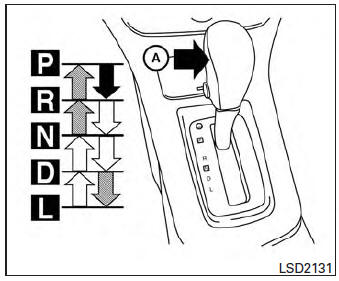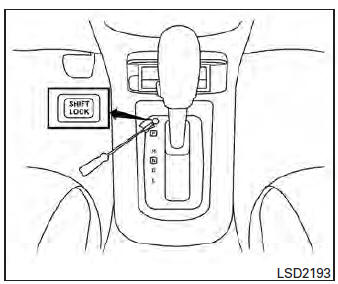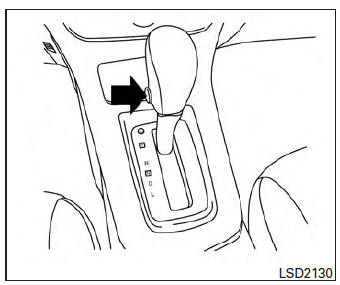Nissan Sentra Owners Manual: Continuously Variable Transmission (CVT) (if so equipped)
WARNING
|
CAUTION
- Except in an emergency, do not shift to
the N (Neutral) position while driving.
Coasting with the transmission in the N (Neutral) position may cause serious damage to the transmission.
- When stopping the vehicle on an uphill grade, do not hold the vehicle by depressing the accelerator pedal. The foot brake should be used for this purpose.
The CVT in your vehicle is electronically controlled to produce maximum power and smooth operation.
The recommended operating procedures for this transmission are shown on the following pages.
Follow these procedures for maximum vehicle performance and driving enjoyment.
NOTE:
Engine power may be automatically reduced to protect the CVT if the engine speed increases quickly when driving on slippery roads or while being tested on some dynamometers.
Starting the vehicle
- After starting the engine, fully depress the foot brake pedal before moving the shift lever out of the P (Park) position.
- Keep the foot brake pedal depressed and move the shift lever into a driving gear.
- Release the foot brake, then gradually start the vehicle in motion.
- Stop the vehicle completely before shifting the shift lever to the P (Park) position.
The CVT is designed so the foot brake pedal MUST be depressed before shifting from P (Park) to any drive position while the ignition switch is in the ON position.
The shift lever cannot be moved out of P (Park) and into any of the other gear positions if the ignition switch is turned to the LOCK or OFF position or if the key is removed.

To move the shift lever:
 Push the button A while
Push the button A while
depressing the
brake pedal
 Push the button A to shift
Push the button A to shift
 Shift without pushing button
Shift without pushing button
Shifting
After starting the engine, fully depress the brake pedal and move the shift lever from P (Park) to any of the desired shift positions.
| WARNING Apply the parking brake if the shift lever is in any position while the engine is not running. Failure to do so could cause the vehicle to move unexpectedly or roll away and result in serious personal injury or property damage. |
If the key is turned to the OFF or ACC position for any reason while the vehicle is in N (Neutral), or any drive position, the key cannot be turned to the LOCK position and be removed from the ignition switch. If this occurs, perform the following steps:
- Apply the parking brake when the vehicle is stopped.
- Move the shift lever to P (Park) to park the vehicle and turn the ignition switch to the LOCK position to remove the key.
P (Park):
CAUTION
To prevent transmission damage, use the P (Park) or R (Reverse) position only when the vehicle is completely stopped.
Use the P (Park) shift lever position when the vehicle is parked or when starting the engine.
Make sure the vehicle is completely stopped.
The brake pedal must be depressed and the shift lever button pushed in to move the shift lever from N (Neutral) or any drive position to P (Park). Apply the parking brake.
When parking on a hill, apply the parking brake first, then place the shift lever into the P (Park) position.
R (Reverse):
CAUTION
To prevent transmission damage, use the P (Park) or R (Reverse) position only when the vehicle is completely stopped.
Use the R (Reverse) position to back up. Make sure the vehicle is completely stopped before selecting R (Reverse) position. The brake pedal must be depressed and the shift lever button pushed in to move the shift lever from P (Park), N (Neutral) or any drive position to R (Reverse).
N (Neutral):
Neither forward nor reverse gear is engaged. The engine can be started in this position. You may shift to N (Neutral) and restart a stalled engine while the vehicle is moving.
D (Drive):
Use this position for all normal forward driving.
L (Low):
Use this position for maximum engine braking on steep downhill gradients/climbing steep slopes and whenever approaching sharp bends. Do not use the L (Low) position in any other circumstances.
Shift lock release

If the battery charge is low or discharged, the shift lever may not be moved from the P (Park) position even with the brake pedal depressed and the shift lever button pressed.
It will be necessary to jump start or have your battery charged, see “Jump starting” in the “In case of emergency” section. Contact your NISSAN dealer or a professional towing service.
To move the shift lever, complete the following procedure:
- Press the ignition switch to the LOCK position.
- Apply the parking brake.
- Using a protective cloth on the tip of a 3 mm screwdriver, remove the shift lock release cover.
- If available, a plastic trim tool can also be used.
- Insert the small screwdriver in the shift lock release slot and push down.
- Move the shift lever to the N (Neutral) position while holding down the shift lock release.
- Push the ignition switch to the ON position to unlock the steering wheel. Now the vehicle may be moved to the desired location.
If the shift lever cannot be moved out of P (Park), have a NISSAN dealer check the transmission as soon as possible.
| WARNING If the shift lever cannot be moved from the P (Park) position while the engine is running and the brake pedal is depressed, the stop lights may not work. Malfunctioning stop lights could cause an accident injuring yourself and others. |
Overdrive (O/D) OFF switch

When the O/D OFF switch is pushed with the
shift lever in the D (Drive) position, the

light in the instrument panel illuminates. See
“Overdrive off indicator light (CVT models)” in the
“Instruments and controls” section of this manual.
Use the Overdrive off mode when you need improved engine braking.
To turn off the Overdrive off mode, push the O/D
OFF switch again. The  indicator
indicator
light will
turn off.
Each time the engine is started, or when the shift lever is shifted to any position other than D (Drive), the Overdrive off mode will be automatically turned off.
Accelerator downshift — in D position —
For passing or hill climbing, depress the accelerator pedal to the floor. This shifts the transmission down into a lower gear, depending on the vehicle speed.
Fail-safe
When the fail-safe operation occurs, the CVT will not be shifted into the selected driving position.
If the vehicle is driven under extreme conditions, such as excessive wheel spinning and subsequent hard braking, the fail-safe system may be activated. The MIL may come on to indicate the fail-safe mode is activated, see “Malfunction Indicator Light (MIL)” in the “Instruments and controls” section. This will occur even if all electrical circuits are functioning properly. In this case, place the ignition switch in the OFF position and wait for 10 seconds. Then place the ignition switch back in the ON position. The vehicle should return to its normal operating condition. If it does not return to its normal operating condition, have a NISSAN dealer check the transmission and repair if necessary.
| WARNING When the high fluid temperature protection mode or fail-safe operation occurs, vehicle speed may be gradually reduced. The reduced speed may be lower than other traffic, which could increase the chance of a collision. Be especially careful when driving. If necessary, pull to the side of the road at a safe place and allow the transmission to return to normal operation, or have it repaired if necessary. |
 Manual transmission (if so equipped)
Manual transmission (if so equipped)
WARNING
Do not downshift abruptly on slippery
roads. This may cause a loss of control.
Do not over-rev the engine when shifting
to a lower gear. This may cause a
loss of con ...
Other materials:
Regulatory Information
FCC Regulatory information
CAUTION: To maintain compliance with
FCC’s RF exposure guidelines, use only the
supplied antenna. Unauthorized antenna,
modification, or attachments could damage
the transmitter and may violate FCC regulations.
Operation is subject to the following two cond ...
Flywheel
Exploded View
Flywheel
Removal and Installation
REMOVAL
Remove the engine and the transaxle assembly from the vehicle, and
separate the transaxle from the
engine. Refer to TM-28, "Exploded View".
Remove flywheel.
Secure flywheel (1) using Tool (A), and remove b ...
Main line between ipdm-e and dlc circuit
Diagnosis procedure
1.Check connector
Turn the ignition switch OFF.
Disconnect the battery cable from the negative terminal.
Check the following terminals and connectors for damage, bend and loose
connection (connector side
and harness side).
Harness connector E4
Harness connec ...

